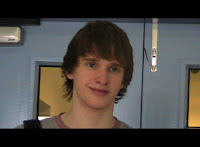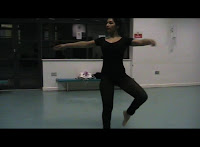Wednesday, 13 May 2009
Monday, 11 May 2009
The project task was to research, plan and create a piece of media. The particular media type I chose to use was film, and so I decided to produce an opening sequence to a film. I then decided to use the teen/dance genre as it particularly appeals to me. Working mostly on my own, it was my job to plan, research, film and edit the footage, as well as providing props, costume, location, and most importantly, cast.
As I have previously stated, the genre of my media product is of the teenage and dance category. To maintain this genre throughout the piece I used locations, props and costume that represented dance. The music played over the opening sequence was relative to classical and contemporary dance too. All these elements, evident during the whole of my sequence, establish the genre and help to sustain it. In true teen/dance genre style, I wished to juxtapose the lives and ‘worlds’ of two characters. Firstly we see the ‘thug-like’ persona, a teenage boy, dressed darkly and lingering in an alleyway. Later, this stereotype is challenged by its extremity, a dancer, teenage, female, dressed in a leotard and in a dance studio environment. These two very different stereotypes contrast greatly and through juxtaposition of scenes and editing as well as character, the separation of these characters and their backgrounds is emphasised. Though these conventions may be typical of any dance film, I decided to include unique elements to create a new product to incite a positive reaction from the voyeur. To create a new and exciting piece of drama I used shots that cut from character to character, feeding the audience with enigmas and in turn answering them as the narrative unravelled. It is the skill and precision required to make these scenes understandable to the voyeur whilst also provoking thought that could possibly make my opening sequence successful and well perceived by the audience. According to the feedback I gained from my questionnaire, 88% of the audience would be impelled to watch a film with such an opening sequence. The 12% that said they would not wish to watch such a film of the teen/dance genre were both of the male gender and uninterested in dance.
In my piece there are two major characters and one minor character. I have attempted to portray particular social groups through the characterisation of these personalities. Firstly, the ‘thug’ persona follows the main stereotypical view of a criminal represented in the media. A darkly clothed, hooded figure lurking in a back alley is exactly how society perceives the majority of male youth today. On the other hand there is the ‘dancer’ character. A feminine, well-presented teenager from a wealthy background, she appears to be in a safe environment. This too adheres to one of many stereotypes shaped by the media. The perception that ‘posh’ teenage girls are funded by their parents in order to partake in luxurious activities such as ballet and contemporary dance is a common one in the eye of media critics and society alike.
To maintain the ‘thug’ stereotype I dressed the character in a dark costume that hid his features and created a sense of intimidation. His strong walk and upright stance highlighted the thug’s aggression and arrogance. Though all the conventions point the finger at this male character being troublesome and a criminal, it is later revealed that we have misconceived his persona. He is in fact a friendly, helpful and harmless young gentleman. This is identified when he offers the dance shoes to the dancer. The light softens at this point to emulate his lighter side.






As this genre has proven popular in many countries across the world, including, most importantly, the UK and the USA, I believe it would be possible for it to be distributed as a professional product. A production company such as Celador (GB), producers and funders of the critically acclaimed and award winning movie ‘Slumdog Millionaire’, would be the ideal company to back this film. They have a varied filmography including the horror, crime, thriller, war and romance genres. It is for the reason that they are yet to promote a film of the dance genre that I believe they would consider backing my media product. They also cover a variation of stereotypes and social groups within their films, so the chance to adopt an ultimately eye opening text of mixed races and youth culture would complement their filmography, whilst communicating a new era of film for the target audience.
The specific target audience for my media product would be both male and female voyeurs, though primarily females as they are more likely to participate in or enjoy dance. I believe such a film would have a wide age range between 10-30 years as its dramatic qualities and sheer entertainment would not fail to interest people. As there are a mix of ethnic backgrounds and nationalities within the opening sequence, the film would most probably appeal to white British people and to British Asians alike, while the possibilities of attracting other ethnic groups and nationalities may be promising upon expansion of the cast. Though the film handles both a ‘wealthy’ aspect and ‘poverty-stricken’ aspect, the voyeur would not have to fit into one of these categories, as the intimate and gritty incite into both worlds will appear intriguing to all economic backgrounds and statuses. As this opening film sequence focuses on the dance genre it is obvious that this is an aspect that will ensue whether a person will choose to watch it. If they are not fond of dance then they may very well not think it is their ‘type’ of film.
However, though dance is the primary genre, the sequence also fits under the categories of romance, crime and youth culture. This widens the potential target audience. A particularly favourable genre to produce, many young people will be persuaded to watch this film, and as young people are the main customers of cinema tickets, a high interest in the film would be undoubtedly imminent. From dance films I have researched, including ‘Honey’, ‘Step Up’ and ‘Save the Last Dance’, they have all earned well through box office sales, a key indication that a dance film like mine can also be successful.
To ensure success at the box office, and indeed any sales point, the film must attract the audience. I believe the main convention that helps to accomplish this is the unique way of presenting the narrative. Cutting back and forth to each character, we see what is happening in two different places at the same moment in time. This creates enigmas about the characters. These enigmas are not yet related, as neither are the people depicted in the scenes. However, as time goes by the two characters meet in their journeys. The voyeur feels a sense of realisation and they can now connect the two characters, meaning enigmas are solved. However, the initial shots still apparent in the voyeur’s mind leave enigmas yet to be answered. Questions into the characters’ pasts and backgrounds are raised. This effectively hooks the audience and propels them into the story and wills them to continue watching. As each shot of the dancer and thug is juxtaposed, we see a reflection in their movement.
This imitation and repetition creates a link between characters, while also founding a binary opposition between the characters. A suggestion of society misunderstanding youth culture is hinted and as the film would develop these issues would be delved into further and with more intimacy. Perhaps taking a more controversial side of the outlook towards youth crime, this challenges the media’s interpretations, a rebellious nature that appeals to the juvenile audience.






Throughout the process of creating my media product, I have learnt to use cameras, MACs and software to my advantage in researching, filming and editing the piece. The internet has allowed me to share files via blogs like Blogger.com and video streams like Youtube. Without these technologies such products would be hard to access and create. A more or less reliable form of production, technology has enabled to do my job quicker, better and more effectively.
From the beginning of the task up to now, I have developed in presenting my skills. My completed media product in comparison to my preliminary task makes use of more conventions and in a more effective and complex way. Elements such as composition, smoothness of editing, narrative presentation, characterisation, sound and lighting are all used in much more effective ways to promote a visually pleasing opening sequence.
Personally, I think I have accomplished the task of creating a film of the teen/dance genre. While having its individual aspects, it is still strong in representing the relationship between the two characters and their involvement in dance. While continuity of shots could have been smoother, I do not think there are many other weaknesses within my media text. I can honestly imagine this article on the big screen, sharing success with its dance genre predecessors.
